 |
| Beautiful! |
 |
| The bluest sky and sea we saw |
Heal Bay
After passing through Freud Passage, we explored Heal Bay. Another cruise-only destination, Heal was a “new” location: G Adventures had never taken passengers there, our landing had not yet been registered among tour operators as an excursion spot and it’s not easily found on the Internet.
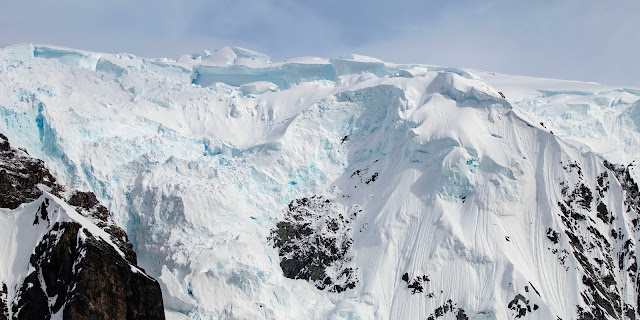 |
| Glacier-topped mountains above the bay |
I am not saying that no humans have ever been there, but maybe …
Surrounded by huge mountains and glaciers, the bay was chock full of giant icebergs.
When I say, giant, I mean really, really huge. Our ship was 344 feet long and some bergs were easily eight times its length. I can’t even estimate their height.
 |
| It such a vast expanse, determining size is very tricky |
The icebergs exhibited all the colors: white, black, brilliant turquoise and a darker blue I hadn’t seen before.
To be classified as an iceberg, the height of the ice must be greater than 14 feet above sea level, the thickness must be 98-164 feet and the ice must cover an area of at least 5,382 square feet.
Icebergs are classified as such:
 |
| Very Large Berg – at least 240 feet tall and 670 feet wide; Photo: Scott Stevens |
 |
| Large Berg – 151-240 feet tall and 401-670 feet wide |
 |
| Medium Berg – 51-150 feet tall and 201-400 feet wide |
 |
| Small Berg – 14-50 feet tall and 47-200 feet wide |
 |
| Bergy Bit – 3-13 feet tall and 15-46 feet wide |
 |
| Growler – less than 3 feet tall and 15 feet wide |
 |
| Brash – chunks of ice |
Here's a really big one, courtesy of Scott.
Of course, measuring icebergs is extremely tricky because what you see isn't what you get. About 90 percent of an iceberg is below the water's surface. That's because the density of ice is 0.92 g/mL, and the density of salt water is 1.03 g/mL. This means that ice has nine-tenths of water's density, hence 90 percent.
 |
| The underwater portion showing through the clear water; Photo: Scott Stevens |
Icebergs can have smooth or sculpted surfaces. Common are grooves that result from melting.
The water in Heal Bay hovered right around freezing, giving it a silky, mercurial look. In some places it was even forming “pancake” ice, lacy round sheets floating on the surface.
 |
| Pancaking is a precursor to actual freezing |
What is amazing to think about when looking at a place like Heal Bay is that the environment is very fragile ...
 |
| Small avalanches |
... and it changes every day ...
 |
| Glaciers calve |
 |
| Icebergs capsize or float |
 |
| Ice melts |
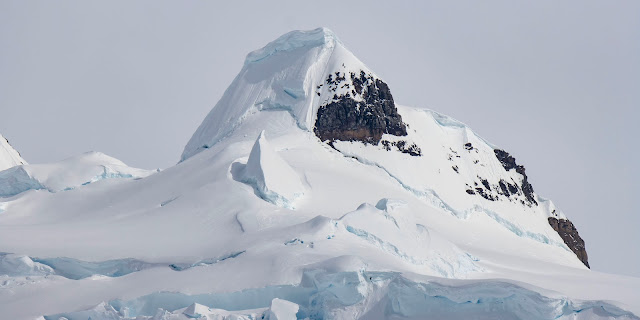 |
| Snow caps the mountains |
 |
| Clouds clear out |
That means that no one else on Earth will ever see it looking the same way it looked when we saw it.
 |
| Just this way for us |
 |
| That's pretty amazing to think about |
With the smooth water, calm wind and gray-to-sunny skies, there were a fair number of birds.
 |
| Southern Giant-Petrel |
 |
| Blue-eyed Shag flying across the face of a glacier |
 |
| Blue-eyed Shag taking off from the bergy bits and brash |
 |
| Kelp Gull flying overhead |
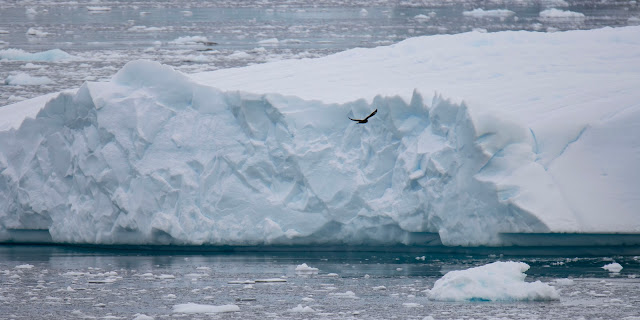 |
| South Polar Skua |
Southern Fulmars
But, the stars of this excursion were the Southern Fulmars flying about and resting on some growlers.
Up to this point, I had been surprised that we weren’t seeing lots of Fulmars on the water. When we were in Svalbard in 2019, we saw hundred of this bird’s relative, the Northern Fulmar, both floating on the water and sitting on the ice along with Arctic Terns and Black-legged Kittiwakes.
 |
| A nice-sized gathering of Southern Fulmars |
In Antarctica, it seemed that the bird volume was less than in the Arctic. Up to Heal Bay, we had seen just a few Fulmars, always flying quickly by. But, here, we saw lots.
 |
| It was nice to get to observe these Fulmars up so close |
The Southern Fulmar, also known as the Antarctic Fulmar or Silver-grey Fulmar, breeds on the coast of Antarctica and the surrounding islands, moving north in winter. It nests in colonies on cliffs, laying a single egg on a ledge or crevice. Its diet includes Krill, fish and squid picked from the water's surface.
 |
| An indelicate take-off |
The name comes from the Old Norse Fúlmár meaning "foul-mew" or "foul-gull" because of the birds' habit of ejecting a foul-smelling oil.
While the birds pictured look small, Fulmars are actually pretty big: 18-20 inches long with a wingspan 43-47 inches.
It is a common species with a population of at least 4 million; a million pairs breed on the South Sandwich Islands alone.
Heal Bay keeps Giving
We also encountered a couple of Weddell seals ...
 |
| One was extremely large and suffering from a runny nose |
At this point my congestion had gotten worse, so I was feeling the same way as the second Seal.
I could have cruised this lovely bay for days, but they made us get back onboard the ship.
Bubble-Net Feeding
Most guests were headed to lunch and we were cruising past some big icebergs, the Captain demonstrating his mad navigation skills. Scott caught some of the action.
Then, we got one of the top wildlife treats of the trip.
We encountered three Humpback Whales, including a calf, “logging” along a “seam” in the water where to currents meet. You could easily see the intersection.
Logging is how Whales sleep, resting on the surface and gently surfacing to breathe.
 |
| Mom and calf at the seam |
One was just hanging suspended in the relatively clear green water. You can easily see its huge, white pectoral fins through the water.
 |
| If you look closely, you can see the full outline of its head |
Scott took a video that caught multiple angles, but not much action (it was SLEEPING!).
As we watched, the Whales woke up and started bubble-net feeding. This feeding behavior is used by Humpback and Bryde's Whales and is one of the few surface feeding behaviors that Humpbacks are known to engage in.
 |
| Mom and baby waking up so mom can feed (the baby is still nursing) |
 |
| The net |
Bubble-net feeding is a cooperative exercise where a group of Whales dive below a school of small prey such as Krill or Herring, and blow bubbles as they circle and slowly move to the surface.
The size of the net they create can range from 10 to 100 feet in diameter. The wall of bubbles confuses the prey, which gathers into a tight ball. Then, the Whales, moving in concert, lunge upwards with their mouths open to feed on the trapped critters.
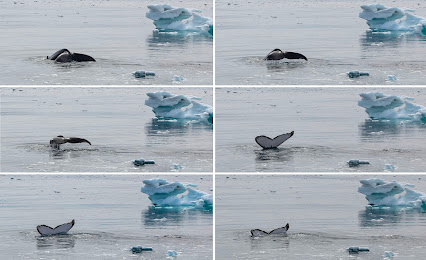 |
| A deep dive |
The Whales can gulp up to 15,000 gallons of water as they feed.
Grooves that run from the chin to the navel allow them to expand their body to take in the massive quantities of water and prey.
Then, they swallow the prey through their grapefruit-sized throats and stream the water out through their baleen (fringed sheets of keratin that line their mouths and act as filters). Since Humpbacks can eat 4,400-5,500 lbs. of Krill per day, this method is efficient.
 |
| Eventually there were five adults and one calf, doing this over and over |
Bubble-netting is an advanced maneuver that is not instinctual; rather it is taught. Not every population of Humpbacks has the skill. In the group we saw, the calf was participating as a training exercise even though it was too young to actually be dependent of Krill rather than mother’s milk. Several times, it crossed the path of some adults, demonstrating that it had not yet mastered the skill.
 |
| Two adults and the "trainee" |
Solitary Whales may engage in similar method referred to as lunge feeding that is similarly executed as the Whale dives down beneath a school of fish and rises to the surface with its mouth wide open. Once it reaches the surface it swallows, separates the fish from the saltwater and spits out the excess water.
From the ship, we could easily see the spiral “nets” the Whales created by blowing bubbles from below. Unlike Whales we have seen doing this in New England and Alaska, these Whales did not breach the surface with their mouths open to gulp prey. That’s because the Krill they were eating was pretty far below the surface. So, by the time they surfaced to breathe, they had already consumed the Krill.
Although we started with three Humpbacks, eventually there were six. The show was un-believe-able. Watch the video I took here and the one Scott took here. Plus, here's some more he took of the swimming Whales.
 |
| With full tummies, swimming away |
What a day! And, we still had one more stop.
Hydrurga Rocks
The afternoon Zodiac excursion was also cruise-only with no shore landings. In some brilliant sunlight, we visited Hydrurga Rocks ...
... where we saw large numbers of our old friends, Chinstrap Penguins, which we hadn't seen since Neko Harbor.
 |
| Chinstrap Penguins at home |
According to my research, about 800 Chinstraps make their summer homes on these low-lying rocky islands.
But, quite frankly, it looked to me like there might be many more. They were everywhere.
 |
| They were on the rock-tops … |
 |
| ... on the shore ... |
 |
| ... in the water ... |
 |
| ... and we even saw some making the transition |
We saw Chinstraps ...
 |
| ... traveling on Penguin Highways ... |
 |
| ... jumping ... |
 |
| ... singing ... |
 |
| ... running ... |
 |
| ... diving ... |
Will We See a Leopard Seal?
Named after the Leopard Seal, whose scientific name is Hydrurga Leptonyx ("thin-clawed water worker"), Hydrurga Rocks was our best bet to see a Leopard Seal.
 |
| Rocky places to hide and oceans to hunt in make this a perfect spot |
We found some Weddell Seals relaxing in the sun and one Seal among them may have been a juvenile Leopard Seal. No one was sure and it didn’t move enough for us to see. But, its longish neck and rounded head could have indicated Leopard Seal.
 |
| After I got home, I decided that it was a Weddell, not a Leopard |
Among the Chinstrap colonies were …
Pure white except for its pink, warty face, the Snowy Sheathbill is 16 inches long with a wingspan of about 30 inches.
 |
| Scavenging on the shore |
Snowy Sheathbills are omnivores, scavengers and kleptoparasites that will eat nearly anything. They steal regurgitated Krill and fish from Penguins feeding their chicks and, given the opportunity, will eat their eggs and chicks.
They also eat carrion, animal feces and, if available, human waste. They have even been known to eat tapeworms from Chinstrap Penguins' intestines. Yuck!
Although the Zodiacs were exactly the same in Hydrurga, I felt so much closer to the water on this excursion, I think it is because there were many Blue-eyed Shags and Chinstrap Penguins swimming all around us.
 |
| Right by the boat |
Hydrurga Rocks is a special memory of the Antarctic Peninsula because, as we toured, the sky got brighter and bluer, highlighting ...
 |
| ... the gorgeous glaciers ... |
 |
| ... snow-covered mountains and the deep blue ocean ... |
 |
| ... and hulking icebergs |
What a wonderful way to end our trip.
Trip date: December 30, 2023 - January 12, 2024
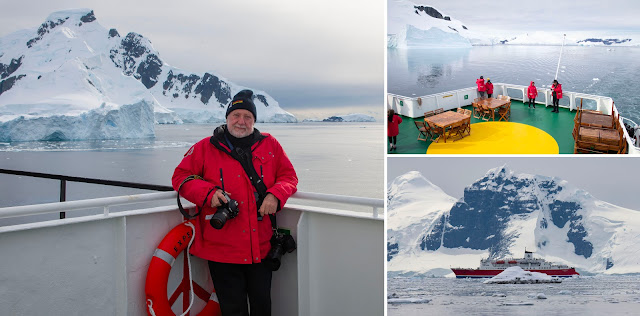


















No comments:
Post a Comment